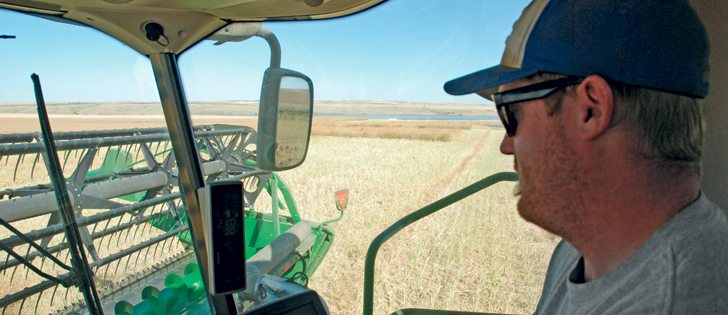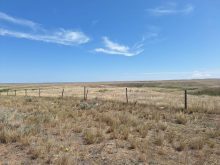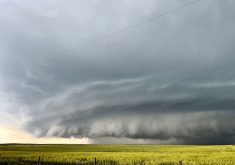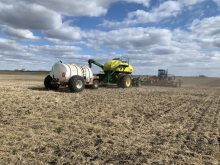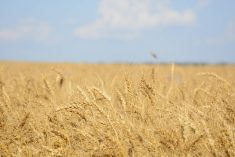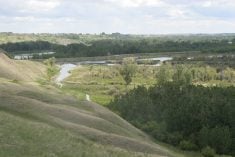If rain makes grain, then farmers near Elrose and Kyle in west-central Saskatchewan could be looking at some big yields this fall — at least in fields that weren’t drowned out or flooded.
The area — about a two-hour drive southwest of Saskatoon — holds the distinction this year of having received more rain than almost any other part of the province since April 1.
“We stopped keeping track (of rainfall) after a while, but there has been a significant amount, that’s for sure,” said Robert Ellis, who farms near Elrose and serves as a municipal councillor in the Rural Municipality of Monet.
Read Also

Farming Smarter receives financial boost from Alberta government for potato research
Farming Smarter near Lethbridge got a boost to its research equipment, thanks to the Alberta government’s increase in funding for research associations.
“We were looking pretty good for a while … but in the middle of July until early August, it just kept coming and wouldn’t shut off.”
In a normal year, growers in Monet and the neighbouring RM of Lacadena expect around 150 millimetres of rain during the growing season.
But this year, some farms received 625 mm or more.
Sloughs are full. Road are under water and farmland that was planted this spring is no longer accessible.
Remarkably, there will be a harvest this year.
A spell of mostly clear, warm weather that began in late August and early September has allowed the land to dry up and the crops to mature.
Last week, dust was flying and combines were busy as they took off what looks to be a bigger-than-average crop.
In fact, most of the grain that’s been coming off over the past two weeks is dry — sometimes too dry to test.
However, evidence of the wet summer is not hard to find.
The water table in the RM of Monet is as high as it’s been for decades, say locals.
Not far from Ellis’s farm, the water in White Bear Lake is close to four metres deep.
That’s deeper than it’s been since the 1950s, according to what the old-timers are saying.
The RM has been pumping water from ditches for much of the summer, and many roadways are impassable, lying under millimetres or sometimes metres of water.
So how’s harvest shaping up in the wake of the prairie monsoon?
“Our lentils suffered pretty bad, but our canola looks really good,” Ellis said.
“Durum? It looks like there’s going to be lots of it but probably not really good quality.”
Farmers in the area are reporting lentil yields of five to 30 bushels per acre, depending on drainage and local rainfall amounts.
But quality is generally poor.
Close to 10 percent of Ellis’s seeded acreage will be lost to flooding.
“Out of the 6,700 acres that we seeded, there’s at least 500 acres, and I might go as far as saying 600 acres that we won’t combine, just because its completely under water.”
Canola fields — those that aren’t flooded — are producing well, with average yields of 50 to 65 bu.
Durum crops will also produce high yields, but top quality durum will be a rarity in the area.
Most of the durum that’s been taken off is grading No. 4, No. 5 or sample.
Further south, Kyle-area farmer Justin Allport offered a similar assessment.
“For the cereals, it looks like good high bushels and for the canola, it’s high bushels as well, but the quality of the durum won’t be the greatest … and the lentils were quite a disappointment,” said Allport, who was harvesting barley Sept. 16.
“I’d say lentil yields were average to below average but poor quality.”
At the family’s main farmyard 13 kilometres north of Kyle, Allport recorded 550 to 575 mm of rain this summer.
Some of their fields received more than that, keeping machine operators on their toes and tow ropes at the ready.
“We’ve been hitting wet spots this year that we never knew we had,” said Allport, a fourth generation farmer.
“Since our family started farming in this area, we’ve never seen it this wet. We’re hitting potholes and water that we’ve never encountered before.”
Despite the obvious harvest challenges, dry harvest weather arrived just in time, he added.
There will be a harvest this year, and probably a big one.
However, with quality concerns looming, no one’s willing to say how the 2016 crop will stack up.
“I won’t know for two more months,” said Allport.
“It’s been an interesting year, to say the least, but we won’t know how things shape up until the smoke all clears.”




